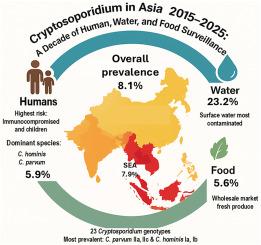Cryptosporidium and cryptosporidiosis: An update of Asian perspectives in humans, water and food, 2015–2025
IF 1.7
Q3 PARASITOLOGY
Current research in parasitology & vector-borne diseases
Pub Date : 2025-01-01
DOI:10.1016/j.crpvbd.2025.100311
引用次数: 0
Abstract
Cryptosporidium species are increasingly recognized as significant enteric pathogens, particularly within developing nations, where they pose serious public health challenges. This systematic review and meta-analysis examine a decade of research (2015–2025) to map the epidemiological footprint of Cryptosporidium across Asia, incorporating 228 studies from 28 countries and analyzing a collective sample of 327,783 specimens collected from humans, water, and food. The overall pooled prevalence was 8.1%, with Southeast Asia emerging as the region of highest concern. Among the affected populations, immunocompromised individuals and children demonstrated the highest vulnerability. Environmental contamination was especially pronounced in surface water sources, while vegetables, particularly those sold in wholesale markets, were the most contaminated food matrices. Molecular findings identified 23 distinct species, and several subtypes predominated by C. parvum (IIa, IId) and C. hominis (Ia, Ib). Notably, some water samples from mixed and surface water sources exhibited extraordinarily high oocyst concentrations, reaching up to 80,000 oocysts/l. Diagnostic approaches varied widely, with a considerable proportion of studies employing traditional non-molecular techniques, thereby highlighting the need for more advanced and standardized detection protocols. Despite regional disparities and methodological variability, the findings reveal a consistent pattern of widespread exposure and environmental circulation of Cryptosporidium species across the continent. This underscores an urgent need for multisectoral collaborations and interventions aimed at bolstering water and food safety infrastructure, enhancing diagnostic capacity, and strengthening public health systems to effectively manage and prevent cryptosporidiosis throughout Asia.

隐孢子虫和隐孢子虫病:2015-2025年亚洲对人类、水和食物的最新看法
隐孢子虫越来越被认为是重要的肠道病原体,特别是在发展中国家,它们对公共卫生构成严重挑战。这项系统回顾和荟萃分析研究了十年(2015-2025)的研究,以绘制隐孢子虫在亚洲的流行病学足迹,纳入了来自28个国家的228项研究,并分析了从人类、水和食物中收集的327,783个样本。总流行率为8.1%,东南亚成为最令人关注的区域。在受影响人群中,免疫功能低下的个人和儿童表现出最高的脆弱性。环境污染在地表水中尤为明显,而蔬菜,特别是在批发市场上出售的蔬菜,是受污染最严重的食物基质。分子鉴定鉴定出23个不同的种,以及以小恙虫(IIa, IId)和人源恙虫(Ia, Ib)为主的几个亚型。值得注意的是,来自混合水源和地表水的一些水样显示出异常高的卵囊浓度,达到80,000个卵囊/升。诊断方法差异很大,相当一部分研究采用传统的非分子技术,因此强调需要更先进和标准化的检测方案。尽管存在区域差异和方法差异,但研究结果揭示了整个大陆隐孢子虫物种的广泛暴露和环境循环的一致模式。这突出表明迫切需要开展多部门合作和干预措施,以加强水和食品安全基础设施,提高诊断能力,并加强公共卫生系统,以便在整个亚洲有效管理和预防隐孢子虫病。
本文章由计算机程序翻译,如有差异,请以英文原文为准。
求助全文
约1分钟内获得全文
求助全文

 求助内容:
求助内容: 应助结果提醒方式:
应助结果提醒方式:


